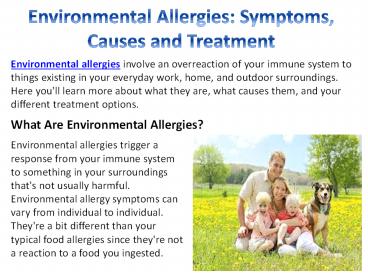Environmental Allergies: Symptoms, Causes and Treatment - PowerPoint PPT Presentation
Title:
Environmental Allergies: Symptoms, Causes and Treatment
Description:
Environmental allergies involve an overreaction of your immune system to things existing in your everyday work, home, and outdoor surroundings. Here you'll learn more about what they are, what causes them, and your different treatment options. Environmental allergies trigger a response from your immune system to something in your surroundings that's not usually harmful. – PowerPoint PPT presentation
Number of Views:37
Title: Environmental Allergies: Symptoms, Causes and Treatment
1
Environmental Allergies Symptoms, Causes and
Treatment
Environmental allergies involve an overreaction
of your immune system to things existing in your
everyday work, home, and outdoor surroundings.
Here you'll learn more about what they are, what
causes them, and your different treatment options.
What Are Environmental Allergies?
Environmental allergies trigger a response from
your immune system to something in your
surroundings that's not usually harmful.
Environmental allergy symptoms can vary from
individual to individual. They're a bit different
than your typical food allergies since they're
not a reaction to a food you ingested.
2
Environmental Allergies Symptoms, Causes and
Treatment
In essence, they're a response to a trigger you
come across in your surroundings or they can also
be a trigger to something you inhale during your
daily activities. There are five primary types
of environmental allergies. These are
- Molds
- Trees
- Dust mites
- Weeds
- Grasses
- These five environmental allergy types account
for around 1.5 million days of school missed each
year and around 28 million lost productivity days
for adults. Worldwide, there's been a 100 rise
in the prevalence of allergic rhinitis or "hay
fever" in each of the last 30 years in developed
countries.
3
Environmental Allergies Symptoms, Causes and
Treatment
What Are the Common Symptoms of Environmental
Allergies?
Environmental allergy symptoms can be similar to
having a cold, but the same thing doesn't cause
them. A cold is caused by a virus, whereas
allergies are a reaction caused by a response
from your immune system to a specific substance
in your surroundings.
- Some environmental allergy symptoms include
- Shortness of breath
- Sneezing
- Itching
- Runny nose
- Fatigue
- Wheezing
- Headaches
4
Environmental Allergies Symptoms, Causes and
Treatment
- What Are the Causes of Environmental Allergies?
- Allergies begin when your immune system
accidently mistakes a substance that is normally
harmless for a dangerous invader. Then your
immune system begins producing antibodies that
stay on alert for this certain allergen. When you
become exposed to this allergen again, the
antibodies release numerous immune system
chemicals like histamine which triggers symptoms. - Some common triggers or causes of environmental
allergies are - Certain foods, especially tree nuts, peanuts,
soy, wheat, shellfish, fish, milk, and eggs. - Airborne allergens like animal dander, pollen,
mold, and dust mites. - Certain medications, especially penicillin-based
antibiotics or penicillin. - Insect stings, like from a wasp or bee.
- Latex or another substance you touch that causes
allergic skin reactions.
5
Environmental Allergies Symptoms, Causes and
Treatment
Environmental Allergy Risk factors You may be
more likely of developing an allergy if you Are
a child Have a family history of allergies or
asthma like hives, hay fever, or eczema Have
asthma or another type of allergic disorder
What Are the Tests for Environmental Allergies?
Environmental allergies testing may
include Skin Testing This is also referred to
as a scratch test where your skin is exposed to
tiny amounts of allergens and the test picks up
environmental allergy triggers like pets, pollen,
mold and dust mites.
6
Environmental Allergies Symptoms, Causes and
Treatment
Blood Testing Your blood is tested to measure
how many immunoglobulin E (IgE) antibodies it has
that are specific to specific allergens. While
blood testing isn't as precise as skin testing,
the doctor might use it in combination with skin
testing in order to diagnose and treat your
allergy.
Controlling your allergies effectively requires
skill, patience and planning. An allergist has
specialized training that allows them to come up
with an effective treatment plan specific to your
individual condition. This treatment plan is
designed to help you live a normal and
symptom-free life as much as possible.
7
Thank You































